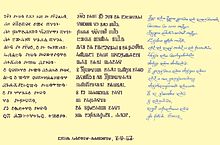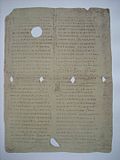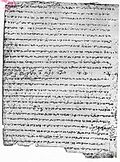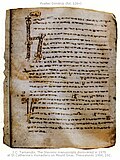Glagolitic script
| Glagolitic script | ||
|---|---|---|
| Font | alphabet | |
| languages |
Old Church Slavonic Bulgarian Croatian Serbian |
|
| inventor | Cyril of Salonica | |
| Emergence | 863 AD | |
| Usage time | Exit 9th to 21st century | |
| Used in | Moravia , Pannonia , Bohemia , Bulgaria , Macedonia , Dalmatia , Istria , Serbia | |
| ancestry |
Protosinaitic script → Phoenician script → Greek alphabet → Glagolitic script |
|
| Derived | Cyrillic alphabet | |
| relative | Cyrillic alphabet | |
| Unicode block | U + 2C00 – U + 2C5F ( Unicode block Glagolitic ) |
|
| ISO 15924 | Glag | |

|
||
The Glagolitic alphabet or Glagolitic (in slawistischer spelling also Glagolica ;. Bulgar./mazedon./slowen./russ glagolica , serbokroat. Glagoljica / глагољица, tschech. Hlaholice , slowak. Glagolitic ) is the oldest Slavic script. The Glagoliza (from Old Church Slavic glagol "language") is a letter script and was invented by Kyrill von Saloniki (826–869).
history
Development of the Glagolitic script

The Glagolitic alphabet was further developed around 863 by the Byzantine monk Konstantin von Saloniki (Kyrill) for the mission in Pannonia and Moravia . Since the Greek alphabet was only suitable to a limited extent for the Slavic languages and Constantine wanted to emphasize the cultural independence of the Slavs, he designed the Glagolitic script as a "spacing script"; d. That is, he based it on the Greek system (letters with phonetic and numerical functions), but created a formally independent, new alphabet. In addition to the Greek minuscule letters , Caucasian (especially Armenian or Georgian ) and Semitic writing systems were used as sources . Geometric shapes such as cross, circle and triangle also played an important role in the design (Christian symbolism?).
From the constructive original form of the Glagolitic a round, then also a square variant developed:
- the round Glagolitsa dominated the Bulgarian- Macedonian- Serbian area,
- the younger angular mainly in Croatia (Dalmatia, Istria).
The Cyrillic script , which emerged in the late 9th century, took over some characters from the Glagolitic script (without numerical value), specifically for sounds that were present in Slavonic but were missing in Greek.
History of scripture use
Kyrill had developed the script for the Slavic languages. The liturgical and theological texts for the building of a church in Moravia and Pannonia were written exclusively in Glagoliza, often as translations of Greek texts. After Method's death in 885, his students left Moravia and went to the Bulgarian Empire . There, more copies and texts in Glagolitic script were made, especially in the school of Ohrid . The Cyrillic script has also developed in the Bulgarian Empire since the 9th century. This completely displaced the Glagoliza there until the 12th century.
In Dalmatia it remained in use for the Catholic liturgy, the clerics who used it were called Glagoljaši . In 1248 Pope Innocent IV allowed to hold mass there in Church Slavonic, the liturgical texts were written in Glagolitic script. In Serbia , the Glagoliza could hold up into the 13th century. The first book printed with Glagolitic letters appeared in Venice in 1483 ( Missale Romanum Glagolitice ).
Glagolitsa persisted particularly on the island of Krk and in the northwestern Croatian region of Istria . The object created in the 19th century national movement of Croats it was a sign of distinction from the Latin West and the Orthodox East. It also remained in use in the Croatian Catholic Church. At the turn of the 19th and 20th centuries, a Catholic Church Slavonic missal in Glagolitic script was published.
The Glagolitsa is still considered a national symbol in Croatia and is often used as an ornament (e.g. as jewelry , on logos or as a tattoo ).
alphabet
The letters of the Glagolitic alphabet:
| Illustration | Unicode characters | description | Transliteration | pronunciation | Probable origin | Modern Slavic-Cyrillic equivalent |
|---|---|---|---|---|---|---|
|
|
Ⰰ | As | azъ | / ɑ / | Sign of the cross, or in Hebrew Aleph א | ( А а ) a |
|
|
Ⰱ | Buky | buky | / b / | Unknown; the Samaritan / m / corresponds to the mirror-inverted letter, Georgian / l / corresponds almost exactly to the letter | ( Б б ) be |
|
|
Ⰲ | Wede | * vědě, vědi | / ʋ / | Probably from the Latin V | ( В в ) ve |
|
|
Ⰳ | Glagoli | glagoli, glagolъ | / ɡ / | (Γ γ) Greek gamma | ( Г г ) ge; see also ( Ґ ґ ) Ukrainian ge |
|
|
Ⰴ | Dobro | dobro | / d / | ( Δ δ ) Greek delta (compare / v / as / d / reversed) | ( Д д ) de |
|
|
Ⰵ | Jest ' | jestъ | / ɛ / | Probably Samaritan / he / or Greek number sampi (900) | ( Е е ) each; see also (Э э) e and ( Є є ) Ukrainian je |
|
|
Ⰶ | Schiwete | * živěti, živěte | / ʒ / | Probably Coptic janja (Ϫϫ) | ( Ж ж ) že |
|
|
Ⰷ | Dselo | dzělo | / ʣ / | Probably Greek stigma (Ϛϛ) | ( Ѕ ѕ ) Macedonian dse |
|
|
Ⰸ | Zemlya | zemlja | / z / | ( Θ θ ) Variant of the Greek theta | ( З з ) ze |
|
|
Ⰺ, Ⰹ | Ische | iže | / i / , / j / | (Ι ι) Greek iota with dieresis | ( И и ) i; also ( Й й ) short i |
|
|
Ⰻ | I. | i | / i / , / j / | Source unknown, probably a combination of the Christian symbols of the circle and triangle | ( І і ) Ukrainian / Belarusian i; also ( Ї ї ) Ukrainian ji |
|
|
Ⰼ | Djerw | / ʥ / | Unknown source | ( Ћ ћ ) Serbian će and later ( Ђ ђ ) Serbian đe | |
|
|
Ⰽ | Cocoa | kako | / k / | From the Hebrew Koph of ק | ( К к ) ka |
|
|
Ⰾ | Lyudie | ljudije | / l / , / ʎ / | (Λ λ) Greek lambda | ( Л л ) el |
|
|
Ⰿ | Myslite | myslite | / m / | (Μ μ) Greek mu | ( М м ) em |
|
|
Ⱀ | Nibble | našь | / n / , / ɲ / | Source unknown | ( Н н ) en |
|
|
Ⱁ | On ' | onъ | / ɔ / | Source unknown | ( О о ) o |
|
|
Ⱂ | Pokoi | pokojь | / p / | ( Π π ) Greek pi | ( П п ) pe |
|
|
Ⱃ | Rzi | rьzi | / r / | ( Ρ ρ ) Greek rho | ( Р р ) er |
|
|
Ⱄ | Slowo | slovo | / s / | Source unknown, probably a combination of the Christian symbols of the circle and triangle | ( С с ) it |
|
|
Ⱅ | Twerdo | tvrьdo | / t / | ( Τ τ ) Greek tau | ( Т т ) te |
|
|
Ⱆ | Uk ' | ukъ | / u / | Ligature of onъ and ižica | ( У у ) u |
|
|
Ⱇ | Ready | morningь | / f / | ( Φ φ ) Greek Phi | ( Ф ф ) ef |
|
|
Ⱈ | Cher | chěrъ | / x / | Unknown, comparable to / g / and the Latin h | ( Х х ) ha |
|
|
Ⱉ | Ot | ōtъ | / ɔ / | Ligature of onъ and its mirror image | ( Ѿ ѿ ) ot (obsolete) |
|
|
Ⱋ | Schta | šta (originally maybe psalmъ and then pěsnь) | / ʃt / | Ligature of ša at the tip of chěrъ (or tvrьdo, less likely) | ( Щ щ ) shcha in Russian, shta in Serbian or Bulgarian |
|
|
Ⱌ | Room | ci | / ʦ / | (ץ) Hebrew Tzade , final form | ( Ц ц ) ce |
|
|
Ⱍ | Cherv | chěrъ | / ʧ / | (צ) Hebrew Tzade , unfinalized form | ( Ч ч ) če |
|
|
Ⱎ | Scha | ša | / ʃ / | ( ש ) Hebrew Shin / ( Ϣ ) Coptic šai | ( Ш ш ) eš or scha |
|
|
Ⱏ | Yer ' | jerъ | / ɯ / | Probably a modification of onъ | ( Ъ ъ ) hard sign |
|
|
ⰟⰊ | Jer | jery | / ɨ / | Ligature, see note below the table | ( Ы ы ) jery |
|
|
Ⱐ | Jerj | jerь | / ɘ / | Probably a modification of onъ | ( Ь ь ) soft sign |
|
|
Ⱑ | Yes | yes | / æ / , / jɑ / | Probably from the epigraphic Greek alpha Α, or a ligature of the Greek E + I | ( Ѣ ѣ ) jat (1917–1918 removed from Russian, 1945 from Bulgarian) |
|
|
Ⱖ | / jo / | ( Ё ё ) o jotified (a hypothetical form) | |||
|
|
Ⱓ | Ju | ü, ju | / ju / | Simplified ligature IOV | ( Ю ю ) ju |
|
|
Ⱔ | little jus | Yes | / ɛ̃ / | ( Ѧ ѧ ) small jus, later ( Я я ) yes | |
|
|
Ⱗ | small jus precluded | * ęsъ | / jɛ̃ / | Ligation of jestъ and nasalization | ( Ѩ ѩ ) Small jus jotified (obsolete) |
|
|
Ⱘ | great jus | * ǫsъ | / ɔ̃ / | Ligature of onъ and nasalization | ( Ѫ ѫ ) Capital jus (removed from Bulgarian in 1945) |
|
|
Ⱙ | great jus prejoted | jǫsъ | / jɔ̃ / | ( Ѭ ѭ ) Large jotified jǫsъ (removed from Bulgarian in the 1910s) | |
|
|
Ⱚ | Fita | ḟita | / θ / | ( Θ θ ) Greek theta | ( Ѳ ѳ ) ḟita (1917–1918 removed from Russian) |
|
|
Ⱛ | Ischiza | ižica | / ʏ / , / i / | Ligature of ižica and jerъ | ( Ѵ ѵ ) Ižica (officially declared obsolete in Russian since the 1870s, but in use until 1917–1918) |
Manuscripts
10th to 13th centuries
| Illustration | designation | Time of origin | Place of origin | Remarks | archive |
|---|---|---|---|---|---|
| Kiev leaves | before 950 | Principality of Pannonia ? | Catholic (!) Missal fragment , seven sheets | Kiev, Academy of Sciences | |
| Codex Assemanianus | 10th or 11th century | Macedonia ( Ohrid School ) | Evangelistary , 158 sheets | Rome, Vatican Apostolic Library, Cod. Slav. 3 | |
| Codex Zographensis | Late 10th century or early 11th century | Macedonia (Ohrid School) | Gospels , 304 sheets (palimpsest) | St. Petersburg, Russian National Library | |
| Codex Marianus | Early 11th century | Macedonia (Ohrid School) | Gospels, 174 sheets | Moscow, Russian State Library, Vienna, Austrian National Library |
|
| Prague leaves | 11th century | Sázava ? Monastery , Bohemia | Prayers, lessonary fragment, two sheets | Prague, cathedral chapter, N 57 | |
| Euchologium Sinaiticum | 11th century | Bulgarian Empire | Euchologion , 137 leaves | Sinai Peninsula, St. Catherine's Monastery | |
| Psalterium Sinaiticum | 11th century | Bulgarian Empire? | Psalter with 15 hymns, 209 leaves | Sinai Peninsula, St. Catherine's Monastery | |
| Rila leaves | 11th century | Bulgarian Empire | Paraenesis of Ephraim the Syrian and prayers, 8 leaves and 3 fragments | Rila Monastery, Cod. 3/6; St. Petersburg, Russian Academy of Sciences, Cod. 25.4.15 | |
| Gospel Achridanum | 11th century | Ohrid? | Evangelistary fragment, two sheets | Odessa, National Scientific Library, Cod. 1/2 (532) | |
| Glagolita Clozianus | 11th century | Macedonia or Dalmatia | Homilies , 14 sheets | Trient, city library; Innsbruck, Tyrolean State Museum | |
| Boyana palimpsest | late 11th century | Ohrid school? | Palimpsest (first writing) in a manuscript from the 13th century | Moscow, Russian State Library, M 1960 | |
| Viennese Glagolitic leaves | Late 11th century or early 12th century | Dalmatia? | Apostolar fragment, two sheets | Vienna, Austrian National Library | |
| Mihanović Apostolar | 11th or 12th century | Zahumlje ? | Apostolar fragment, 2 leaves | Zagreb, Academy of Sciences and Arts | |
| Gršković Apostolar | 12th Century | Zahumlje? | Apostolar fragment, 4 leaves | Zagreb, Academy of Sciences and Arts | |
| Dimitar Psalter | 12th or 13th century | northeastern Bulgarian Empire | Psalms, prayers, recipes against diseases, 154 sheets | Sinai Peninsula, St. Catherine's Monastery |
14th to 19th century
| Illustration | designation | Time of origin | Place of origin | Remarks | archive |
| Missal from Prince Novak | 1368 | Krk, Dalmatia | Missal , with miniatures | Vienna, Austrian National Library | |
| Evangelistary of Reims | 1395 (Glagolitic part) | Prague, Emmaus Monastery ? | Evangelistary, 31 sheets in a Cyrillic manuscript from the 11th century. | Reims, Bibliothèque municipale | |
| Missal from Prince Hrvoje | around 1404 | Split , Dalmatia, | Missal, 247 leaves | Istanbul, Topkapi Sarayi Library | |
| Croatian Lucidarius | first half of the 15th century. | Dalmatia | Compendium on theological and scientific topics, translation of the Latin Elucidarium | ||
| Breviary of Priest Mavra | 1460 | Vrbnik , Krk | Breviary , 417 sheets | Zagreb, Academy of Sciences and Arts | |
| Missale Romanum Glagolitice | 1483 | Venice? or Kosinj, Croatia? | Roman Catholic Missal, first printed Glagolitic book | ||
| Glagolitic New Testament | 1562 and 1563 | Tübingen | First New Testament in Glagolitic script, made to spread reformatory efforts among the Croatian and Slovenian populations in the Habsburg monarchy | ||
| Missale Romanum Slavonico idiomate | 1631 | Rome | New version of the Roman Missal |
Inscriptions
| Illustration | designation | Time of origin | place | Remarks |
|---|---|---|---|---|
| inscription | early 10th century | Veliki Preslaw , round church | a short inscription and an alphabet | |
| inscription | probably 10th century | Cave monastery near Murfatlar , Dobruja | ||
| Inscriptions | 11th to 13th centuries | Novgorod , St. Sophia Cathedral | 10 inscriptions | |
| Baška tablet | around 1100 | Krk, Dalmatia | Foundation text for a church | |
| inscription | Bededictine monastery of St. Cosmas and Damian on the Cokovac mountain near Tkon on the island of Pasman |
Monuments
| Illustration | designation | Time of origin | place | Remarks |
|---|---|---|---|---|
| Plaque | 1944 | Zagreb , cathedral | text | |
| Glagolitic avenue | 1976 | Istria | ||
| signpost | Drivenik | |||
| graffiti | 2003 | Zagreb | ||
| Glagolitic path | since 2006 | Baška , Krk | Glagolitic stone letters | |
| Street name | Dobrinj , Krk |
Another monument with the inscription "Sunčanik" is in Senj, exactly at the 45th parallel .
See also
See also
literature
- Dobrowsky’s Glagolitica. About Glagolitic literature, the age of the Bukwitza, the pattern according to which it was formed, the origin of the Roman-Slavic liturgy, the quality of the Dalmatian translation which was ascribed to Jerome. 2. improved and much increased edition. Mayregg, Prague 1832.
- Sharon Golke Fullerton: Paleographic Methods used in Dating Cyrillic and Glagolitic Slavic Manuscripts. Department of Slavic Languages & Literatures - Ohio State University, Columbus OH 1975 ( Ohio State University Slavic Papers. 1).
- Helmut Jachnow: A new hypothesis on the provenance of the Glagolitic script - reflections on the 1100th year of death of Methodius of Saloniki. In: Renate Rathmayr (Hrsg.): Slavistische Linguistik 1985. Papers of the XI. Constance Slavic Working Meeting, Innsbruck, 10. – 12. September 1985. Sagner, Munich 1986, ISBN 3-87690-345-9 , pp. 9-93 ( Slavistic contributions 200).
- V. Jagić : Glagolitica. Appreciation of newly discovered fragments. Tempsky, Vienna 1890 ( Memoranda of the Imperial Academy of Sciences. Philosophical-Historical Class. Vol. 38, Abh. 2, ISSN 1012-4861 ).
- Valentin Kiparsky: Tschernochvostoffs theory about the origin of the Glagolitic alphabet. In: Manfred Hellmann u. a. (Ed.): Cyrillo-Methodiana. On the early history of Christianity among the Slavs. 863-1963. Böhlau, Cologne a. a. 1964, pp. 393-400 ( Slavistic Research 6, ISSN 0583-5437 ).
- Heinz Miklas (Ed.): Glagolitica. To the origin of the Slavic writing culture. Publishing house of the Austrian Academy of Sciences, Vienna 2000, ISBN 3-7001-2895-9 ( Austrian Academy of Sciences. Philosophical-Historical Class. Philological Department. Writings of the Balkan Commission. 41)
- Heinz Miklas: The Slavic writings: Glagolica and Kyrillica. In: Wilfried Seipel (Ed.): The Tower of Babel. Origin and diversity of language and writing. Volume 3: Scripture. Volume: A. Kunsthistorisches Museum u. a., Vienna a. a. 2003, ISBN 3-85497-055-2 , pp. 243–249 (exhibition catalog).
- František Přikryl: Monuments of St. Constantine (Cyril) and Method in Europe. H. Kirsch, Vienna 1920, p. 92ff.
Web links
- Croatian Glagolitic Script very informative (English)
- Croatian Glagolitic Manuscripts held outside of Croatia Glagolitic manuscripts and prints outside Croatia (English)
- University paper on the historical development of Glagolica and Kyrillica (German)
- Glagolitic scripts (Croatian)
- Further information (Croatian)
- Istarski razvod 1325/1546
- Images of various Slavic scripts. Bamberg University
Individual evidence
- ↑ Martin Eggers: The Archdiocese of Method. Location, Effect and Afterlife of the Cyrillomethodian Mission. Verlag Otto Sagner, 1996, p. 89, University of Michigan - 2008.
- ↑ Klaus Buchenau: Orthodoxy and Catholicism in Yugoslavia 1945–1991 . A Serbian-Croatian comparison. Harrassowitz Verlag, Wiesbaden 2004, p. 45 f .
- ↑ Anna-Maria Meyer: On the use of the Glagolica today (based on tattoos and prints) . In: The world of the Slaves . No. 1/2015 , 2014 ( online [accessed May 11, 2014]).
- ↑ Слава въ вишнихъ Богу На въспоминание 1300 го лѣта крьщениѣ Народа Хръватъ иже закле се вѣчьною вѣрьностью Стѣнѣ Петра приемъ отъ её обѣтование помощи въ вьсакои печали Дружьба Братие Хръватъскаго Змьѣ съхранѣе светине прадѣди Прѣпоручае Отьчьство Хръватъ Великои Богородици 1941
- ^ The Baška Glagolitic Path on the island of Krk. croatia.org, 2007, accessed March 12, 2016 .

























